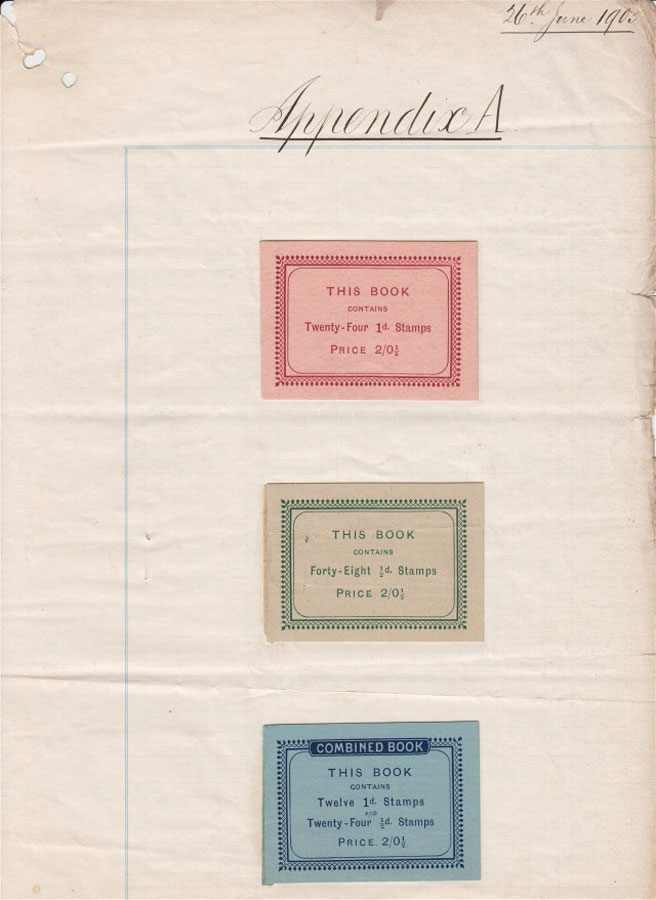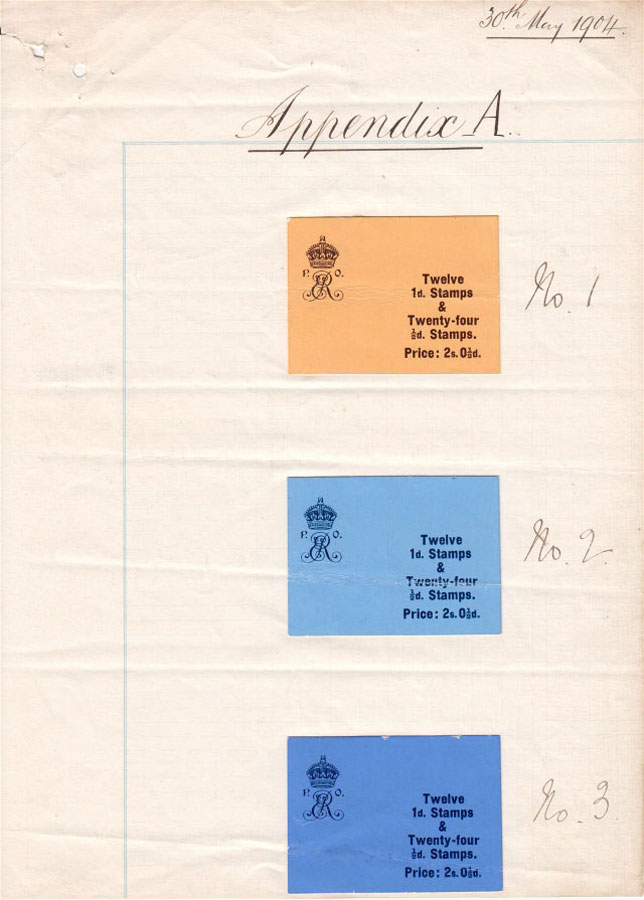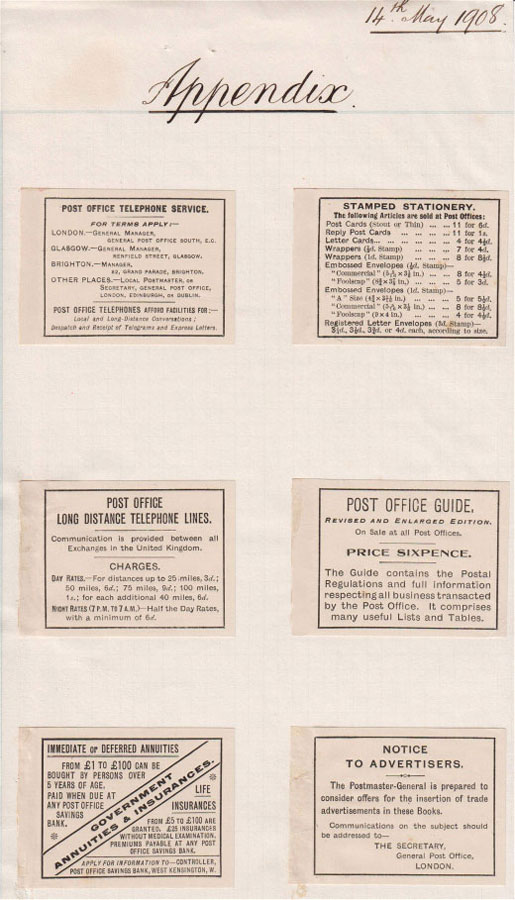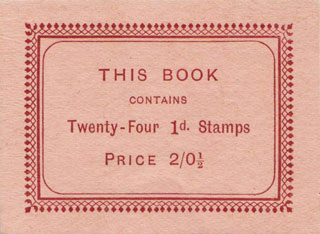
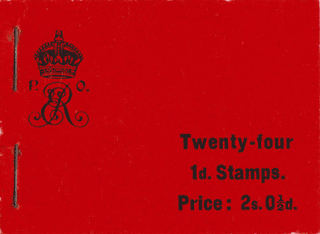
Books of stamps were proposed during the reign of Queen Victoria, but it was during the reign of King Edward VII, on 16 March 1904, that the first Post Office booklet was issued. It contained 24 penny stamps in four panes of six.
Seven editions were printed containing King Edward VII stamps, the first six by De La Rue, but in 1911 the printing contract changed from De La Rue to Harrison, and Harrison printed one last booklet of the reign in 1911, although the King had died in 1910. These editions were unnumbered but have been given numbers (1) to (7).
Each booklet sold for ½d over the face value of its stamps. The first edition cost 2/0½d but the second edition had a cross in place of one of the ½d stamps reducing the cost to an even 2/-.
From 22 June 1911 (the coronation day of King George V) booklets were sold at face value, and unsold copies of King Edward VII booklets were endorsed by hand with “1/11½”. The PMG wrote in his 1913-14 report: since that date the sale of these books has increased from about one million a year to about eight millions a year.
| (1) | Mar 1904 | 24 x 1d |
| (2) | June 1906 | 12 x 1d, 23 x ½d |
| (3) | Aug 1907 | 18 x 1d, 11 x ½d |
| (4) | Aug 1908 | Interleaves printed in red |
| (5) | Aug 1909 | — in green (Chas. Baker) |
| (6) | Aug 1910 | — in green (Brimsdown) |
| (7) | June 1911 | Printed by Harrison |
To see all seven King Edward VII booklets click here.
Trials and Essays
In June 1903 essays were produced by De La Rue. On 26 June three essay booklets together with suggested cover designs were sent to the Inland Revenue. The booklet panes were made from counter sheet stamps, cancelled with wavy pen lines. The booklets were forwarded to the Post Office on 9 July for comment, and are presumed to be now held in the Postal Museum, although they have not been seen for quite some time.
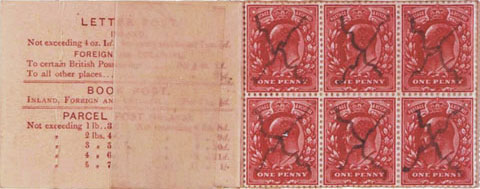
This cover design shows “Twenty-Four 1d Stamps” on the front at a price of “2/0½”, and a Royal Cypher on the back. The inside has the same postal notice as the essay booklets but with some manuscript corrections.
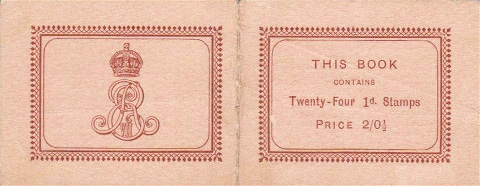
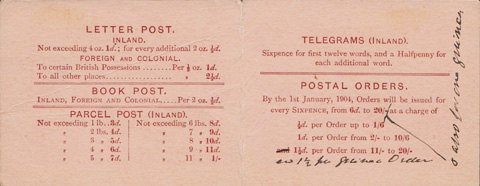
The suggested cover designs were for 24 1d stamps in pinkish-brown, 48 ½d stamps in pale green, and a combined cover of 12 1d and 24 ½d stamps in pale blue.
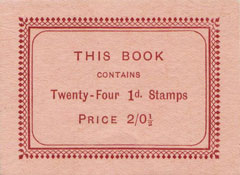
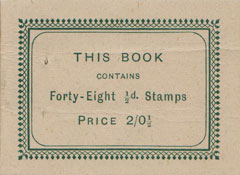
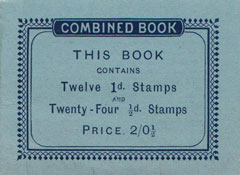
The rest of 1903 saw much activity producing essays and trials for the cover materials, for the cover design, for interleaves, and for the layout of the printing plates. On 1 June 1903, a plate layout of 20 upright and 20 inverted panes was suggested by Mr. King of the Post Office. This was approved and three penny printing plates were produced in July/Aug 1903 (plates 57/201, 58/202, and 59/203). The first of which was registered on 18 Sept 1903.
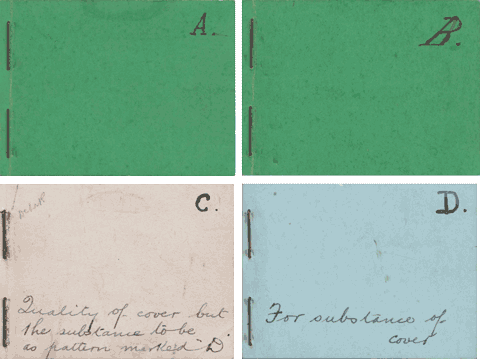
Trials for the quality and substance of the cover, marked A, B, C, and D.
Card covers with panes of Minerva Head stamps and plain interleaves.
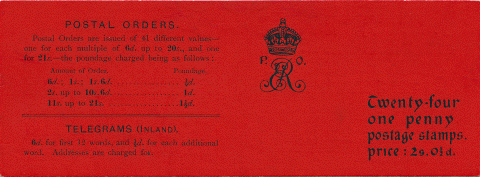
10 Sept 1903 proof of the adopted cover (one of four in various shades of red), designed by H. J. Howard of the secretary’s office, GPO. The front cover set in “Kelmscott” type.
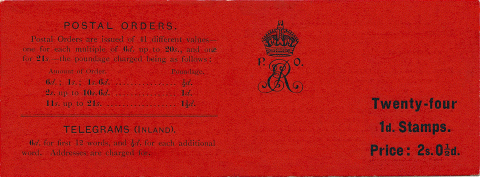
23 Sept 1903 corrected proof with the front cover reworded and set in sans-serif type. Minor corrections were made to the inside of the cover, “thin” changed to “Thin”, “9lbs” to “9lb”, and “11lbs” to “11lb”.

20 Oct 1903 trial with enamelled covers, red outside and cream inside, containing four panes of six perforated blank labels and glassine interleaves.

27 Nov 1903 as above but with matt covers, red both sides. Not adopted.
2s Booklet Series 1: BA1
The first booklet containing 24 one penny stamps.

Date: Mar 1904
Editions: (1)
Printer: De La Rue
Watermark: Imperial Crown
Makeup: FC, int, MB5, int, MB5, int, MB5, int, MB5, int, BC
Interleaves: Unprinted grease proof paper
Cancels: 16 (Ex Apr 1984 NPM sale)
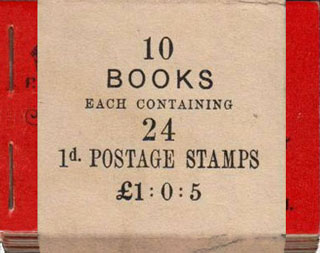
A pack of ten BA1 booklets with a buff wrapper band.
Halfpenny Trials and Essays
Only two months after the first booklet was issued, there were trials for booklet covers including halfpenny stamps, which would be useful to pay the postcard rate. Trials for BA2 booklet covers were submitted on 30 May 1904 in yellow-buff, pale blue, and cornflower blue, and on 29 Aug 1904 in various shades of green. The trials were as the issued booklet except for “&” instead of “and”, and showing “Twelve 1d Stamps & Twenty-four ½d Stamps” priced at 2s0½d. Perhaps shades of green were considered to indicate that these booklets contained ½d green stamps, but this was not adopted.
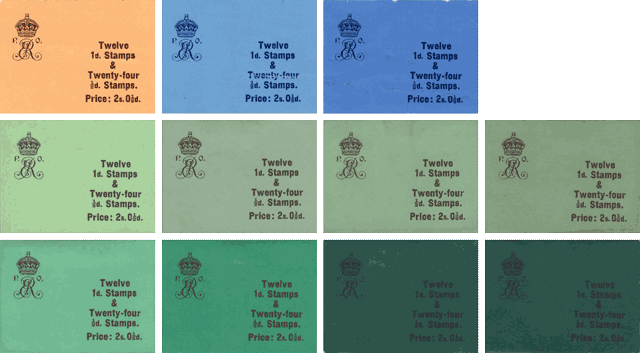
It was more than two years later before the next booklet was issued. By then it had been realised that the price of 2s0½d was inconvenient for both customers and counter clerks, so one ½d stamp was to be removed, and the selling price reduced to 2s. An essay with panes of De La Rue dummy stamps (2 panes in red, 4 in green) had a hand-painted St. Andrew’s cross pasted over one stamp on the last pane.
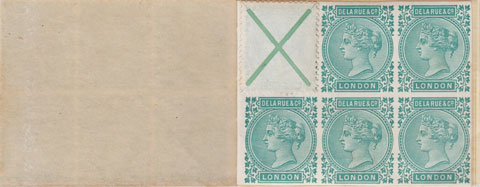
A die proof of the St. Andrew’s cross was prepared on 24 Jan 1906, and four halfpenny printing plates were produced in Feb 1906, two without crosses (plates 54/254 and 55/255) and two with crosses (plates 56/256 and 57/257). One of each was registered in Mar 1906.
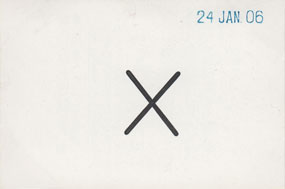
2s Booklet Series 1: BA2
New makeup to include halfpenny stamps.
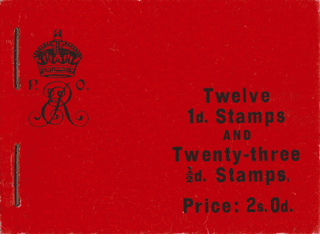
Date: June 1906
Editions: (2)
Printer: De La Rue
Watermark: Imperial Crown
Makeup: FC, int, MB5, int, MB5, int, MB1, int, MB1, int, MB1, int, MB2, int, BC
Interleaves: Unprinted grease proof paper
Cancels: 17, A
The inside back covers of editions (1) and (2) are different.
Egypt was added to the first group, Australia removed from second.
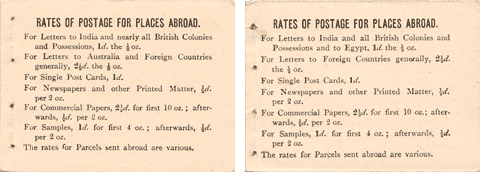
Editions (1) and (2) inside back covers.
2s Booklet Series 1: BA3
Makeup changed again to include more penny and less halfpenny stamps.
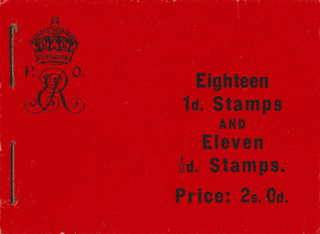
Date: Aug 1907
Editions: (3), (3a)
Printer: De La Rue
Watermark: Imperial Crown
Makeup: FC, int, MB5, int, MB5, int, MB5, int, MB1, int, MB2, int, BC
Interleaves: Unprinted grease proof paper
Cancels: A
The inside back covers of editions (3) and (3a) are different.
“See current Post Office Guide” was replaced by specific rates.
Just under a half million of each were issued.
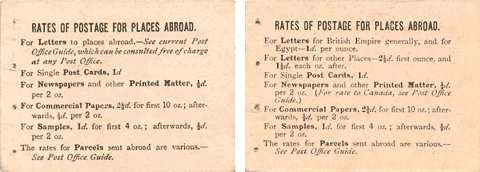
Editions (3) and (3a) inside back covers.
2s Booklet Series 1: BA4
Same as BA3 but with interleaves printed in red.
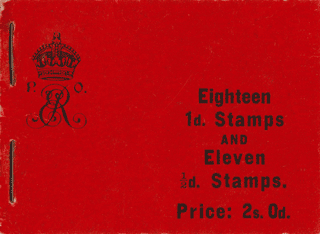
Date: Aug 1908
Editions: (4)
Printer: De La Rue
Watermark: Imperial Crown
Makeup: FC, int, MB5, int, MB5, int, MB5, int, MB1, int, MB2, int, BC
Interleaves: Post Office notices in red on grease proof paper
Cancels: 17, A
The Post Office wanted to use the six interleaves to generate some advertising revenue. Of 24 potential advertisers, none were interested in this booklet, so six Post Office notices were included instead, the last of which was a solicitation to advertisers. The inside back cover was the same as that used in edition (3a).
To see the interleaves, see Adverts & Interleaves below.
Trials for printed interleaves were made using perforated plain paper and waxed interleaves printed with “The Laws of Bridge”. One booklet was printed in black, one in red, and one in blue. The cover was as BA2; however, this is thought to be a trial for BA4, although the date is not known.

The Laws of Bridge trial.
2s Booklet Series 1: BA5
Same as BA4 but with interleaves printed in green.
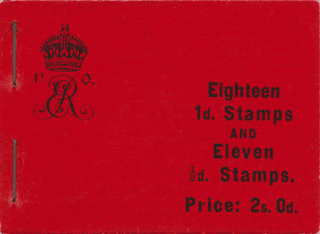
Date: Aug 1909, Aug 1910
Editions: (5)-(6)
Printer: De La Rue
Watermark: Imperial Crown
Makeup: FC, int, MB5, int, MB5, int, MB5, int, MB1, int, MB2, int, BC
Interleaves: Adverts in green on white paper
Cancels (5): 17, A
Cancels (6): 22, B, C, D, “ECE”, “ECQ”, E
With the introduction of advertising, trial booklets were prepared containing adverts printed in both dark green and dark blue. These were made up with Minerva Head dummy stamps.

Trial in dark green with the advert for Robbialac set at an angle.

Trial in dark blue with the advert for Chas Baker set differently.
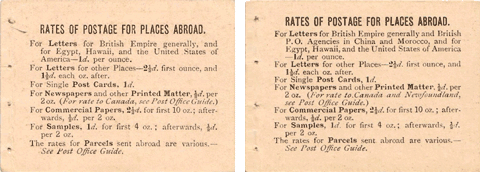
Editions (5) and (6) inside back covers.
2s Booklet Series 1: BA6
On 1 Jan 1911 the printing contract changed to Harrison.
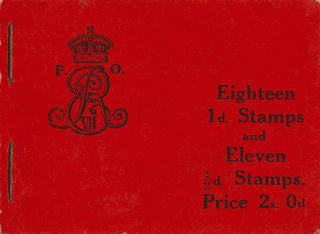
Date: June 1911
Editions: (7)
Printer: Harrison
Watermark: Imperial Crown
Makeup: FC, int, MB6, int, MB6, int, MB6, int, MB3, int, MB4, int, BC
Interleaves: Post Office notices in green on white paper
Cancels: 22, E
Harrison used a larger Royal Cypher on the front cover.
Proofs of the new cover design were taken on white paper.
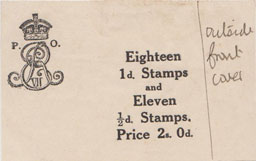
A booklet BA5(6) with stamp panes cancelled “London Chief Office, E.C.” Type E served as an essay for the interleaf notices with typewritten announcements pasted in.

A trial for make-up was made with notices printed in black, without stamps. The fourth and fifth notices were swapped with “BOOKS OF STAMPS — ADVERTISEMENTS” printed on the front of the fifth interleaf instead of the back of the fourth interleaf.

De La Rue Appendices
Several De La Rue Appendix sheets came to market in the 11 May 1977 Robson Lowe auction. In addition to those shown below, there was an appendix with eight booklet covers in various shades of green dated 29 Aug 1904, and an appendix with a package label (200 books) and a wrapper (10 books) dated 15 February 1906.
Click the images to enlarge.
Local Editions
On 8 Oct 1910, the Post Office accepted Sells Ltd as the advertising contractor. On 14 Oct 1910, Sells suggested that advertising should be split into districts, so that advertisers could target specific areas. They made an essay from a cancelled KEVII booklet with a piece of white paper pasted on the cover inscribed Thames Valley Area. The idea was not adopted but Sells followed up with six cover essays printed in black on red card inscribed Cardiff, Glasgow, Liverpool, Manchester, Newcastle, and Thames Valley.
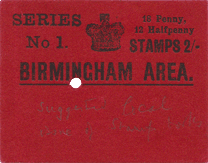
An additional essay inscribed Birmingham Area is in private hands.
All Values Trial
Circa 1911 there was a trial booklet containing all 13 stamp values from ½d to 1s with a BA6 cover and various interleaves. The idea was not adopted.
Click the image to enlarge.
Price Reduction
From 22 June 1911 (the coronation day of King George V) booklets were sold at face value, and unsold copies of King Edward VII booklets were endorsed by hand with “1/11½”. The PMG wrote in his 1913-14 report: since that date the sale of these books has increased from about one million a year to about eight millions a year.

Booklets BA5 and BA6 with manuscript “1/11½”.
Booklet Panes
Booklet panes of six were printed in letterpress, each sheet having 240 stamps arranged as 20 upright panes, and 20 inverted. Cancellations (precancellations, “specimen” and “cancelled” overprints) are equally likely to be found on upright or inverted panes, unless otherwise noted.
Sheets for editions (1)-(6) were perforated by De La Rue using a horizontal comb machine which had a single extension pin at each end, and which perforated through the central gutter. This produced perforation Type B1(E) at the sides of the sheet, and Type B1A(P) in the middle.
Sheets for edition (7) were perforated by Harrison using a horizontal comb machine with a single extension pin that produced perforation Type B1(E) only.
Full sheet reconstructions are shown under Sheets & Perforations.
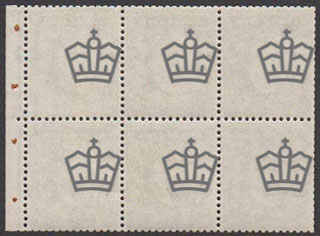
Watermark Imperial Crown.
The Imperial Crown watermarks are typically offset left or right. Booklet stamps were printed on the same Crown Mill Sheets as counter sheet stamps, the vertical gutter causing the offset.
All King Edward VII panes are stapled.
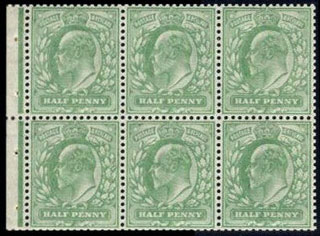
MB1/a: De La Rue; Booklets BA2-5; Perfs E, P; Cancels 17, 22, A, B, C, D, E
MB3/a: Harrison; Booklets BA6; Perfs E; Cancels 22, E
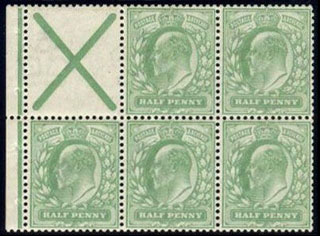
MB2/a: De La Rue; Booklets BA2-5; Perfs E, P; Cancels 17, 22, A, B, C, D, E
MB4/a: Harrison; Booklets BA6; Perfs E; Cancels 22, E
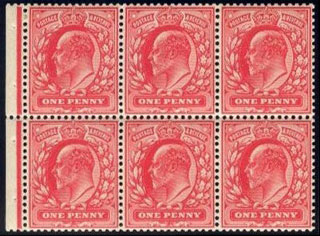
MB5/a: De La Rue; Booklets BA1-5; Perfs E, P; Cancels 17, 22, A, B, C, D, E
MB6/a: Harrison; Booklets BA6; Perfs E; Cancels 22, E
(MB5asa: Type 16. Ex Apr 1984 NPM sale)
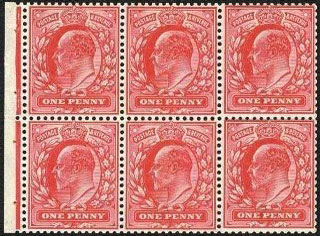
Variety MB6b: Displaced clichés (R1/3, R2/3) showing rightmost two stamps slightly higher.
(Watermark upright only, thought to be caused by a repair to the third column of the plate.)
(Incorrectly listed as MB5b in some catalogues.)
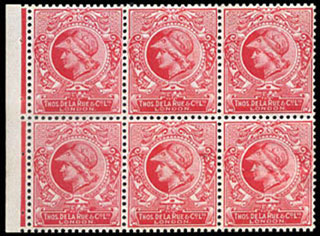
Minerva Head dummy stamp pane, used in some De La Rue trial booklets.
Adverts & Interleaves
In edition (4) Post Office notices are printed on the front of each of the six interleaves. In editions (5), (6), and (7) the first five interleaves are printed on the back, and the sixth interleaf is printed on the front.
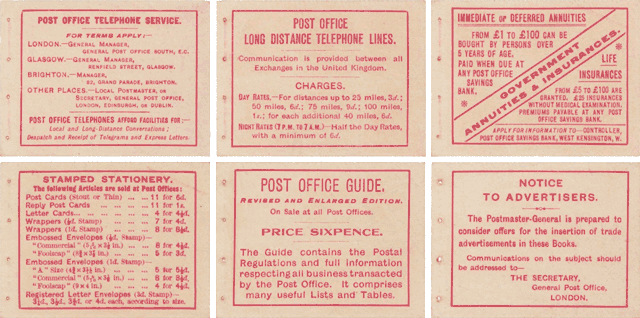
Edition (4) interleaves.
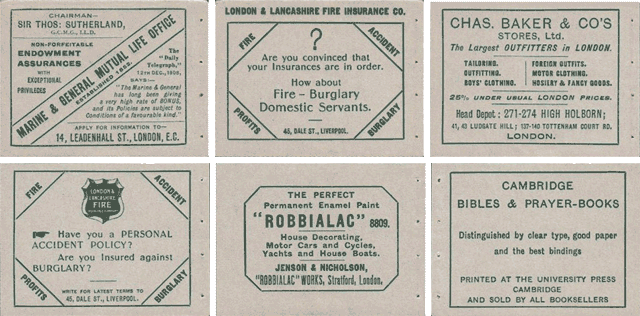
Edition (5) interleaves.
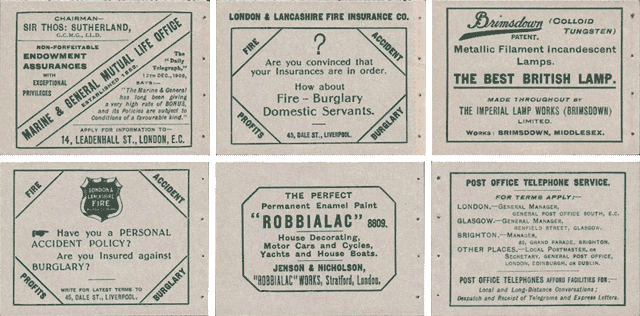
Edition (6) interleaves (3rd and 6th adverts replaced).
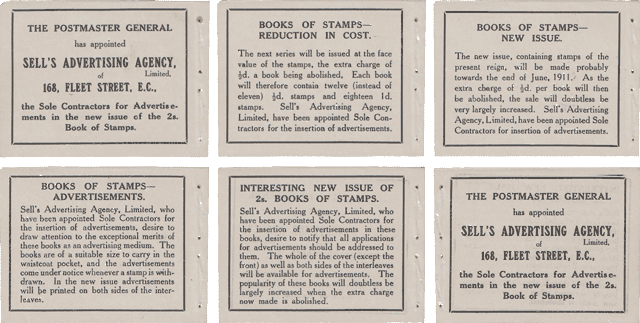
Edition (7) interleaf proofs in black.
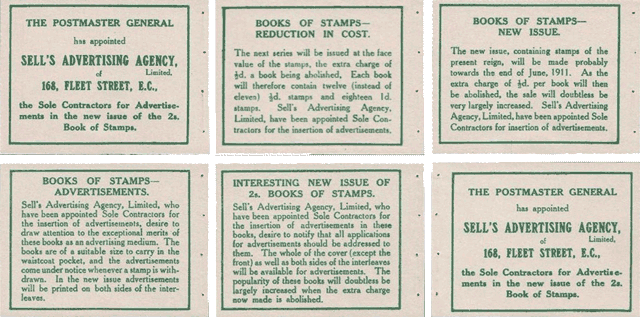
Edition (7) interleaves.
